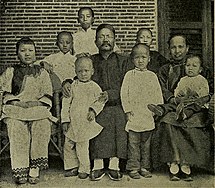
Back Mìng-nàng-nè̤ng CDO Hoklo German Hokloj Esperanto Hoklo Spanish مردم هوکلو Persian Hoklot Finnish Hokkien (peuple) French Orang Min Selatan ID Hoklo Italian 閩南民系 Japanese
This article needs additional citations for verification. (August 2022) |
闽南人 | |
|---|---|
 A Hokkien family in Southern Fujian, 1920 | |
| Total population | |
| 60,000,000 (est.)[1] | |
| Regions with significant populations | |
| Mainland China | Southern Fujian parts of Guangdong parts of Zhejiang |
| Taiwan | 22,277,000 (est.) |
| Malaysia | Largest group of Malaysian Chinese[quantify] |
| Singapore | Largest group of Chinese Singaporeans[quantify] |
| Philippines | Largest group of Chinese Filipinos[quantify][2] |
| Indonesia | Largest group of Chinese Indonesians[quantify][3] |
| Brunei | Largest group of Bruneian Chinese[quantify] |
| Myanmar | One of the four largest groups of Burmese Chinese[quantify][4] |
| United States | 70,000+[5] |
| Vietnam | 45,000 (est.) |
| Languages | |
| Religion | |
The Hoklo people (Chinese: 福佬人; Pe̍h-ōe-jī: Ho̍h-ló-lâng) are a Han Chinese subgroup[6] who speak Hokkien,[7] a Southern Min language,[8] or trace their ancestry to southeastern Fujian in China,[9] and known by various related terms such as Banlam people (闽南人; Bân-lâm-lâng), Minnan people, Fujianese people or more commonly in Southeast Asia as the Hokkien people (福建人; Hok-kiàn-lâng).[a] The Hokkien people are found in significant numbers in mainland China, Taiwan, Hong Kong, Macau, Singapore, Malaysia, Philippines, Indonesia, Brunei, Myanmar, and the United States. The Hokkien people have a distinct culture and architecture, including Hokkien shrines and temples with tilted sharp eaves, high and slanted top roofs, and finely detailed decorative inlays of wood and porcelain. The Hokkien language, which includes Taiwanese Hokkien, is the mainstream Southern Min, which is partially mutually intelligible to the Teochew language, Hainanese, Leizhou Min, and Haklau Min.
- ^ 闽南文化研究. 海峡文艺出版社. 2004. ISBN 9787806409633.
- ^ Ng, Maria; Holden, Philip, eds. (1 September 2006). Reading Chinese transnationalisms: society, literature, film. Hong Kong University Press. p. 20. ISBN 978-962-209-796-4.
- ^ Lewis, M. Paul, ed. (2005), "Indonesia", Ethnologue: Languages of the World (15th ed.), Dallas, T.X.: SIL International, ISBN 978-1-55671-159-6, retrieved 26 January 2010.
- ^ Mya Than (1997). Leo Suryadinata (ed.). Ethnic Chinese As Southeast Asians. Palgrave Macmillan US. ISBN 0-312-17576-0.
- ^ 2005-2009 American Community Survey
- ^ Damm, Jens (2012). "Multiculturalism in Taiwan and the Influence of Europe". In Damm, Jens; Lim, Paul (eds.). European perspectives on Taiwan. Wiesbaden: Springer VS. p. 62. ISBN 9783531943039.
- ^ Bolton, Kingsley; Botha, Werner; Kirkpatrick, Andy (14 September 2020). The Handbook of Asian Englishes. John Wiley & Sons. ISBN 9781118791653.
- ^ Ding 2016, p. 1.
- ^ Ding 2016, p. 3.
Cite error: There are <ref group=lower-alpha> tags or {{efn}} templates on this page, but the references will not show without a {{reflist|group=lower-alpha}} template or {{notelist}} template (see the help page).